41st Oi Match Game 1
Black: Habu Yoshiharu, Oi
White: Tanigawa Koji, Challenger
41st Oi-sen, Game 1, July 10th and 11th 2000
1.P7g-7f 1/1 0/0
2.P3c-3d 0/1 5/5
3.P6g-6f 1/2 0/5
4.R8b-3b 0/2 21/26
5.S7i-6h 9/11 0/26
6.P3d-3e 0/11 7/33
7.S6h-6g 4/15 0/33
8.K5a-6b 0/15 8/41
9.B8h-7g 9/24 0/41
10.K6b-7b 0/24 3/44
11.R2h-8h 10/34 0/44
A surprise. This is the 105th game that Habu and Tanigawa have played against
each other, but it is only the second time that the opening is Ai Furibisha.
However, in a way it is also the second time in a row that this opening is
played. In the final game of the Oi title match last year (Habu won 4-0 then),
the opening was also Ai Furibisha. There Tanigawa played a fast climbing
silver attack with S3c~S4d~S3e. Here, he opts for a slow approach.
12.P3e-3f 0/34 11/55
13.P3gx3f 3/37 0/55
14.R3bx3f 0/37 0/55
15.S3i-2h 3/40 0/55
16.P1c-1d 0/40 13/68
17.P8g-8f 16/56 0/68
18.G4a-5b 0/56 17/85
19.P8f-8e 21/77 0/85
Black wants to exchange pawns on the 8th file as soon as white blocks the
sideways working of the rook. If white avoids this block, it will be more
difficult to develop the silver.
20.R3f-3d 0/77 3/88
21.K5i-4h 11/88 0/88
22.S3a-3b 0/88 24/112
23.G6i-5h 15/103 0/112
24.B2b-1c 0/103 39/151
25.P6f-6e 26/129 0/151
26.N2a-3c 0/129 6/157
27.P*3g 27/156 0/157
28.P2c-2d 0/156 17/174
29.K4h-3h 52/208 0/174
30.P2d-2e 0/208 5/179
31.G4i-4h 1/209 0/179
32.S7a-8b 0/209 9/188
33.B7g-6f 14/223 0/188
34.G6a-6b 0/223 48/236
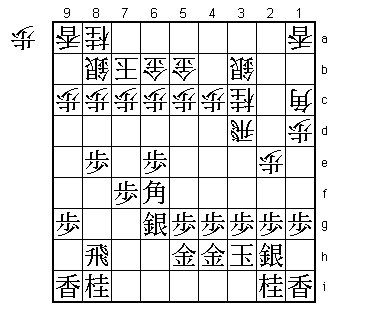
The sealed move. Both players have been very careful about developing their
pieces. White has a pawn in hand and an active rook, but he has trouble with
the development of his left silver, therefore the position is unclear.
35.P1g-1f 7/230 0/236
36.R3d-2d 0/230 17/253
37.S6g-5f 18/248 0/253
38.P2e-2f 0/248 10/263
39.P2gx2f 23/271 0/263
40.R2dx2f 0/271 0/263
41.P8e-8d 0/271 0/263
42.P8cx8d 0/271 2/265
43.R8hx8d 1/272 0/265
44.P*8c 0/272 0/265
45.R8d-3d?! 38/310 0/265
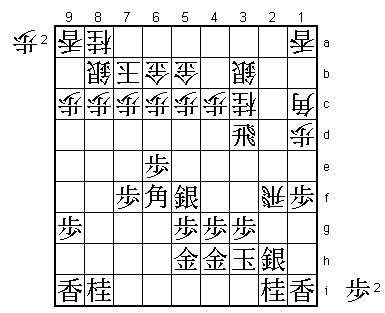
After a long, slow build-up, Habu decides to open the hostilities. He did
not like 45.R8f R2d P*2g P4d N7g R3d P9f P4e P9e S4c as white has an extra
pawn in hand and has also managed to develop the silver. Tanigawa agreed
that this variation is not bad for white.
46.P4c-4d 0/310 31/296
47.P1f-1e 59/369 0/296
A change of plan. At first, Habu thought that he could play 47.Bx4d here as
it attacks the rook. However, after 47.Rx2h+ Kx2h G4c, black loses material.
Habu is lucky that his oversight is not leaving him with a bad position.
48.G5b-4c 0/369 22/318
49.R3d-3f 1/370 0/318
50.R2fx3f 0/370 55/373
51.P3gx3f 0/370 0/373
52.R*6i 0/370 0/373
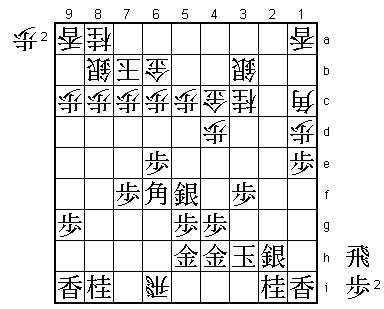
This double attack on bishop and knight looks really good for white. However,
with the wall silver on 8b and the bad position of the white gold on 4c,
things are not so easy.
53.P1ex1d 4/374 0/373
54.P*1h 0/374 0/373
55.L1ix1h 14/388 0/373
56.R6ix8i+ 0/388 1/374
57.P*2g! 4/392 0/374
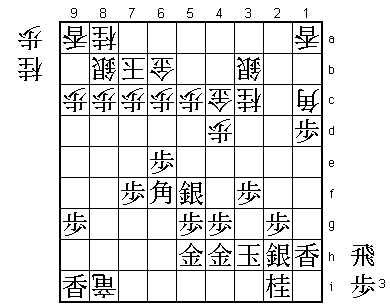
Strong defence. Black plays a defence only move just after white won material.
This usually is a sign of trouble, but here white has no good way to continue
his attack.
58.B1c-3a 0/392 0/374
59.P6e-6d 0/392 0/374
Black attacks on the famous weak point of the white castle: "the rabbit ear".
60.B3a-4b 0/392 1/375
No choice. 60.Px6d R*5a N*4a P*6c loses quickly.
61.P6dx6c+ 2/394 0/375
62.G6bx6c 0/394 0/375
63.P1d-1c+ 0/394 0/375
64.+R8i-6i? 0/394 5/380
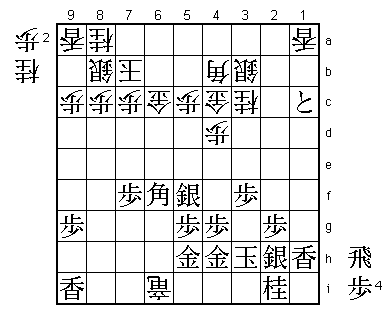
The losing move. Tanigawa thought he was forcing Habu into P*6g or P*6h here,
which would seriously weaken black's attack on the 6th file as there are no
longer pawn drops possible. The game sequence without 64.+R6i would have
been much better: 66.P5d P*1b P*3g Nx3g P*1g Lx1g N*2d R*2f and white has
no pawns so it looks a little difficult to continue the attack. However,
N4e looks very strong, so the position is still unclear.
65.B6f-7g! 10/404 0/380
Simple, but strong. Although this bishop is undefended here, white can not
attack it without losing too much time.
66.P5c-5d 0/404 4/384
67.P*1b 7/411 0/384
68.P*3g 0/411 43/427
69.N2ix3g 5/416 0/427
70.N*2d 0/416 2/429
71.R*2b 11/427 0/429
72.N2dx3f 0/427 17/446
73.R2bx3b+ 3/430 0/446
74.P*1g 0/430 9/455
75.G5h-5i! 7/437 0/455
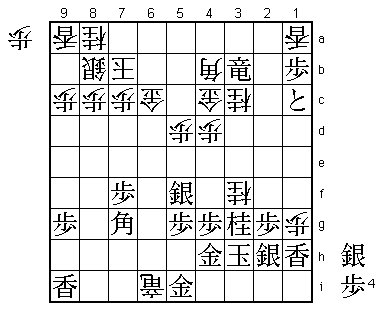
The reason why 64.+R6i was bad. This gold move makes black's king safe and
attacks the white dragon at the same time.
76.+R6ix5i 0/437 2/457
77.B7gx5i 0/437 0/457
78.P1gx1h+ 0/437 0/457
79.+R3bx4c 3/440 0/457
80.+P1hx2h 0/440 1/458
81.K3h-4i 0/440 0/458
82.G*5a 0/440 2/460
83.S*5b 3/443 0/460
Resigns 0/443 0/460
Time: 07:23:00 07:40:00
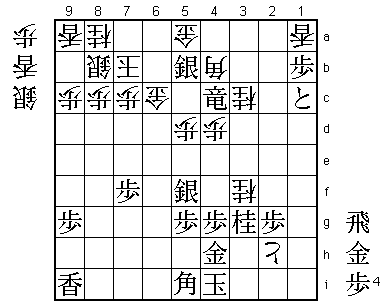
White can try a number of checks after 83.Nx4h+, but they will all come to
nothing. On the other hand, white's king can not be defended with the silver
on 8b blocking the escape.
A good start for Habu, but a close game that will not discourage Tanigawa
much. He is black in the second game and will no doubt play his favourite
Kakugawari opening, in which he is almost unbeatable.






